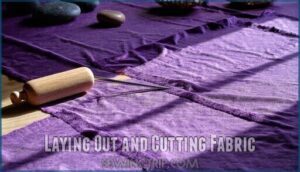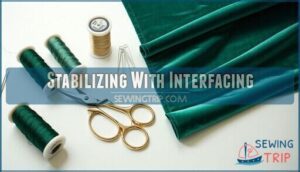This site is supported by our readers. We may earn a commission, at no cost to you, if you purchase through links.

Cut fabric in single layers with sharp shears, using pattern weights instead of pins. A walking foot prevents creeping during stitching. Mark only on the wrong side with washable markers.
Steam gently instead of pressing directly to preserve the pile. The secret lies in understanding stretch velvet’s unique behavior compared to regular velvet.
These fundamentals reveal professional results, but the real magic happens when you discover sophisticated techniques for handling tricky corners and curves.
Table Of Contents
Key Takeaways
- You’ll need specific tools and settings: use a 75/11 stretch needle, polyester thread, and lower your machine tension to 3-4 to prevent puckering and maintain fabric flexibility.
- You must cut stretch velvet in single layers with sharp tools and use pattern weights instead of pins to avoid distortion and damage to the delicate pile.
- You should use a walking foot and hand-baste seams before machine stitching to prevent the fabric layers from creeping and shifting during sewing.
- You can’t press stretch velvet directly with an iron—instead, steam gently from 6 inches away or use a pressing cloth on low heat to preserve the luxurious pile texture.
Essential Tools and Supplies for Stretch Velvet
You’ll need the right tools to tackle stretch velvet’s tricky combination of luxurious pile and stretchy fibers.
Start with a 75/11 stretch needle, fine polyester thread, sharp fabric scissors, and washable fabric markers that won’t damage the delicate surface.
Needle and Thread Selection
Choosing the right needle types and thread material makes all the difference when sewing with velvet. You’ll want ballpoint or stretch needles in sizes 75/11 to 90/14 for stretch compatibility without snagging.
Polyester thread offers the flexibility your seams need, while silk thread works beautifully for hand basting. Color matching matters too—weight considerations guarantee your stretch velvet tips pay off with professional results.
To prevent damage, consider using Clover Wonder Clips within the seam allowance.
Choosing The Right Sewing Machine Settings
Once you’ve selected your needle and thread, your sewing machine needs fine-tuning for stretch velvet success. Lower your tension adjustment to 3-4 to prevent puckering. Set stitch length at 2.5mm for balanced flexibility.
Use a walking foot or Teflon presser foot to prevent fabric creeping. For stretch velvet, engage differential feed if available. A pin feed system is ideal for sewing velvet.
These sewing machine settings make all the difference when working with this tricky fabric.
Recommended Cutting Tools and Marking Methods
Sharp fabric shears and rotary cutters become your best friends when cutting velvet—they slice cleanly through slippery fabric without snagging the pile. **Investing in quality cutting tools is worthwhile.
Sharp tools make all the difference when cutting velvet without damaging that luxurious pile
**
Use pattern weights instead of pins to avoid distortion, and mark with tailors chalk or disappearing marking pens on the wrong side. Trust me, your universal machine needles will thank you later!
Preparing Stretch Velvet for Sewing
You’ll need to prep your stretch velvet carefully before you start sewing, since this luxurious fabric can be tricky but rewarding to work with.
Proper preparation saves you from headaches later and ensures your finished project looks professional and fits beautifully.
Laying Out and Cutting Fabric
Lay out your pile fabric on a large, flat surface to prevent stretching during cutting and marking. Use pattern placement with grain alignment, securing fabric with weights instead of pins.
Cut stretch velvet in single layers using a sharp rotary cutter for precise cutting direction. Consider exploring options for rotary cutter materials to refine your cutting process.
This prevents slippage while maintaining the fabric’s integrity throughout your cutting and marking process.
Marking and Maintaining Nap Direction
After your fabric’s cut, marking becomes your roadmap to success. Every pattern piece needs identical nap directionality – imagine velvet texture as tiny soldiers marching the same direction. Use tailor’s tacks with silk thread on the wrong side since chalk crushes pile fabric. Consider using specialized marking tools for delicate fabrics. Test your cutting layout under good lighting; misaligned nap shows instantly once assembled.
- Feel the difference – stroke "pile up" for richness, "pile down" for smoothness
- Protect your investment – wrong-side marking prevents costly pile damage
- Achieve professional results – consistent fabric grain creates perfect color matching
- Save time later – accurate marking now prevents frustrating rework
- Build confidence – proper cutting and marking techniques guarantee stunning outcomes
Stabilizing With Interfacing
Once you’ve marked your pattern pieces, it’s time to give stretch velvet some backbone. Skip fusible interfacing—heat flattens pile permanently. Instead, hand-baste silk organza or lightweight sew-in interfacing to collars and waistbands. This prevents stretching while preserving that luxurious texture you’re working so hard to protect.
| Interfacing Type | Best For | Why It Works |
|---|---|---|
| Silk Organza | Structured areas like collars | Won’t crush pile, maintains drape |
| Knit Interfacing | Stretch zones and curved seams | Moves with fabric, prevents distortion |
| Sew-in Lightweight | Waistbands and buttonholes | No heat damage, easy removal if needed |
Step-by-Step Sewing Techniques for Stretch Velvet
Now you’ll master the actual sewing process that transforms your prepared stretch velvet into beautiful, professional-looking garments.
These proven techniques will help you handle stretch velvet’s unique challenges, from preventing fabric distortion to creating strong, flexible seams that move with the fabric’s natural stretch.
Preventing Velvet Creeping and Distortion
You’ll tackle velvet creeping like a pro with proper basting techniques and tension adjustments. Hand-baste seams before machine sewing to prevent pile fabric layers from shifting. Hold stretch velvet taut without stretching during fabric handling.
Reduce presser foot pressure for seam stabilization. These sewing techniques guarantee cutting accuracy translates to distortion-free results when sewing velvet.
Stitching Methods for Stretch Seams
When sewing velvet, zigzag stitching becomes your best friend for stretch seams. Use a narrow zigzag (2.5mm width) or overlock seams to prevent popping. Twin needle techniques create professional hems, while coverstitch use mimics ready-to-wear finishes. Elastic thread in the bobbin adds extra give.
These sewing techniques help avoid velvet creeping while maintaining stretch. Selecting the right needles and thread is essential for a smooth finish.
Pressing and Steaming Tips
Never use a regular iron directly on stretch velvet—it’ll crush the pile faster than you can say "fabric disaster." Steam vs. iron becomes essential here: hold your steamer 6 inches away, letting gentle steam revive the velvet pile without contact.
For pressing seams, place a pressing cloth between iron and fabric, using low temperature control. Professional pressing tools like a velvet board prevent crushing while maintaining stretch velvet’s luxurious texture.
Hemming and Finishing Stretch Velvet Projects
You’re almost at the finish line, and this final step makes all your hard work shine! Getting clean hems and professional seam finishes on stretch velvet requires patience, but you’ll love how polished your finished garment looks.
Hemming Options and Temporary Adhesives
Perfect hems on stretch velvet require strategic timing and technique. Hang your garment 24 hours before hemming—this prevents wonky results from natural stretching.
Hand-sewn blind hems using catchstitch work beautifully with fine silk thread. Adhesive hemming tape designed for stretch fabrics creates stable fold lines. Single-fold hems reduce bulk while maintaining drape.
To prevent puckering, consider using a ballpoint needle. Test hemming techniques on scraps first.
Seam Finishes to Prevent Bulk and Fraying
Clean finishes make all the difference when working with stretch velvet. Serged edges create professional seam finishes while preventing fraying and reducing bulk. You can also zigzag raw seam allowances for similar results.
Avoid topstitching on stretch velvet—it adds unwanted thickness. Instead, trim seam allowances and grade them to minimize bulk at intersections.
Trimming and Cleaning Up Velvet Fuzz
Velvet’s fuzzy nature means you’ll be dealing with lint throughout your project. Here’s how to tackle the cleanup:
- Use handheld vacuums or lint rollers to remove fine fibers from your workspace
- Clean your sewing machine after cutting velvet to prevent mechanical issues
- Brush garments with soft, dry brushes to restore flattened pile
- Remove residual fuzz from seams using fine lint rollers
- Gently groom pile with a blunt knife for uniform texture
Troubleshooting and Care Tips for Stretch Velvet
Even with perfect technique, stretch velvet can throw you curveballs like excessive shedding, lost stretch, or stubborn wrinkles that make you wonder if your fabric is plotting against you.
Don’t worry—most velvet mishaps have simple fixes, and proper care will keep your gorgeous garments looking luxurious for years to come.
Handling Shedding and Stretch Issues
Shedding happens with every velvet project, but you can minimize velvet shedding by finishing raw edges with zigzag stitches. Use clips instead of pins to reduce friction and prevent excessive handling that stretches fabric.
To prevent puckering, it’s important to use proper tension control. Keep your walking foot engaged while sewing at low speeds to manage creeping and maintain consistent nap direction throughout your project.
Fixing Common Sewing Mistakes
When seam puckering strikes, adjust your machine’s tension and use a walking foot for even feeding. Skipped stitches usually mean switching needles or reducing speed.
For uneven hems from fabric slippage, hand-baste first.
Pressing velvet requires steam—never direct iron contact—to revive crushed pile without damage.
Washing, Drying, and Storing Velvet Garments
After fixing those sewing mistakes, proper care keeps your stretch velvet looking fresh. Hand washing with cold water and mild detergent protects the pile best.
Here’s your care routine:
- Air-dry flat on towels to prevent stretching
- Steam gently instead of pressing velvet directly
- Store folded or rolled, never hanging
- Blot stains with cool water, avoiding harsh scrubbing
These velvet washing methods and storage solutions prevent crushing while maintaining that luxurious texture.
Frequently Asked Questions (FAQs)
How do I prevent the nap from getting crushed when marking the fabric?
Like walking on eggshells, you’ll need gentle handling here.
Mark velvet patterns on the wrong side using fabric chalk or water-soluble markers. This protects the delicate pile from crushing while keeping your markings crisp and clear.
What type of thread should I use when sewing stretch velvet?
You’ll want fine polyester thread for stretch velvet since it moves with the fabric without breaking. Silk thread works great for hand basting, but polyester manages the stretch better for machine seams and won’t snap under tension.
Can I use an iron to press stretch velvet?
You can press stretch velvet, but use extreme caution.
Set your iron to low heat with no steam, and always press from the wrong side using a pressing cloth to protect the pile.
Is it necessary to line stretch velvet garments?
Lining stretch velvet isn’t always necessary, but it’s often wise. **You’ll want lining for structure, comfort against skin, and preventing stretching out.
**
Skip it for casual tops where drape matters most.
Can you sew stretch velvet without serger?
You can definitely sew stretch velvet without a serger! Use a narrow zigzag stitch or stretch stitch on your regular machine to maintain fabric elasticity and prevent seams from popping.
What patterns work best with stretch velvet?
Picture luxurious stretch velvet draping beautifully across your form. You’ll find semi-fitted and loosely-fitted patterns work best since they complement velvet’s natural weight and drape without fighting the fabric’s stretch.
How do you prevent stretch velvet pilling?
You’ll prevent pilling by using quality polyester thread, gentle hand-washing in cold water, air-drying flat, and storing garments with tissue paper between folds to minimize friction.
Can stretch velvet be machine embroidered safely?
Yes, you can machine embroider stretch velvet, but use stabilizer, reduce tension, and choose simple designs. Test first on scraps to prevent puckering or pile damage.
Whats the best way to repair tears?
Like mending a delicate friendship, repairing stretch velvet tears requires gentle patience.
You’ll want to use fusible interfacing behind the tear, then hand-stitch with matching thread using tiny ladder stitches that follow the fabric’s natural grain direction.
Conclusion
Many sewers worry that stretch velvet’s luxurious texture makes it too difficult for beginners, but you’ve now learned how to sew stretch velvet successfully with the right techniques.
Your 75/11 stretch needle, polyester thread, and careful tension adjustments will transform this challenging fabric into stunning garments. **Remember to cut single layers, use a walking foot, and steam gently rather than press directly.
With practice, you’ll create professional-quality pieces that showcase velvet’s beautiful drape and rich texture.
- https://sewgoth.com/tips-for-working-with-stretch-velvet/
- https://knitfabric.com/sewing-with-stretch-velvet-fabric
- https://www.reddit.com/r/sewing/comments/13l4fi2/tips_for_working_with_stretch_velvet/
- https://wunderlabel.com/blog/p/14-tips-working-velvet/
- https://blog.closetcorepatterns.com/tips-for-sewing-with-velvet/















